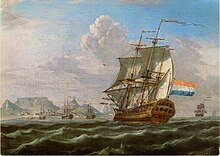
A national flag is a flag that represents and symbolizes a given nation. It is flown by the government of that nation, but can also be flown by its citizens. A national flag is typically designed with specific meanings for its colours and symbols, which may also be used separately from the flag as a symbol of the nation. The design of a national flag is sometimes altered after the occurrence of important historical events. The burning or destruction of a national flag is a greatly symbolic act.

The national flag of the Netherlands is a horizontal tricolour of red, white, and blue. The current design originates as a variant of the late 16th century orange-white-blue Prinsenvlag, evolving in the early 17th century as the red-white-blue Statenvlag, the naval flag of the States-General of the Dutch Republic, making the Dutch flag the oldest tricolour flag in continuous use. As a flag that symbolises the transformation from monarchy to republic, it has inspired both the derivative Russian flag, and after the French Revolution in 1789, the vertically striped French tricolour; both flags in turn influenced many other tricolours. During the economic crisis of the 1930s, the old Prince's Flag with the colour orange gained some popularity among some people. To end the confusion, the colours red, white and blue and its official status as the national flag of the Kingdom of the Netherlands were reaffirmed by royal decree on 19 February 1937.

The Union Jack or Union Flag is the de facto national flag of the United Kingdom. The Union Flag was also used as the official flag of several British colonies and dominions before they adopted their own national flags. The flag continues to have official status in Canada, by parliamentary resolution, where it is known as the Royal Union Flag.

The national flag of France is a tricolour featuring three vertical bands coloured blue, white, and red. It is known to English speakers as the Tricolour, although the flag of Ireland and others are also known as such. The design was adopted after the French Revolution, where the revolutionaries were influenced by the horizontally striped red-white-blue flag of the Netherlands. While not the first tricolour, it became one of the most influential flags in history. The tricolour scheme was later adopted by many other nations in Europe and elsewhere, and, according to the Encyclopædia Britannica has historically stood "in symbolic opposition to the autocratic and clericalist royal standards of the past".

Orange is the colour between yellow and red on the spectrum of visible light. Human eyes perceive orange when observing light with a dominant wavelength between roughly 585 and 620 nanometres. In traditional colour theory, it is a secondary colour of pigments, produced by mixing yellow and red. In the RGB colour model, it is a tertiary colour. It is named after the fruit of the same name.

The flag of South Africa was designed in March 1994 and adopted on 27 April 1994, during South Africa's 1994 general election, to replace the previous flag used from 1928–1994.

Greater Netherlands is an irredentist concept which unites the Netherlands, Flanders, and sometimes Brussels. Additionally, a Greater Netherlands state may include the annexation of the French Westhoek, Suriname, formerly Dutch-speaking areas of Germany and France, or even the ethnically Dutch and/or Afrikaans-speaking parts of South Africa, though such variants are mostly limited to far-right groups. A related proposal is the Pan-Netherlands concept, which includes Wallonia and potentially also Luxembourg.
A triband is a vexillological style which consists of three stripes arranged to form a flag. These stripes may be two or three colours, and may be charged with an emblem in the middle stripe. All tricolour flags are tribands, but not all tribands are tricolour flags, which requires three unique colours.

The flag of the Orange Free State was officially used from 1857 to 1902. It was superseded by the flag of the Orange River Colony.

The flag of Sint Maarten consists of a white triangle situated at the hoist charged with the constituent country's coat of arms, along with two horizontal bands of red and blue. Adopted in 1985 shortly after the territory was granted a coat of arms, it has been the flag of Sint Maarten since 13 June of that year. Since the dissolution of the Netherlands Antilles on 10 October 2010, it has been the sole flag used in the constituent country.

The Flag of New Holland, also known as the flag of Dutch Brazil, was the flag used by the Dutch West India Company for the territories that were under its control in Brazil from 1630 until 1654. In this period, Brazil was not granted its own flag, and only the flags of its colonizers or rulers were used.

The King's Dutch Brigade was a brigade of the British army, organised by the Hereditary Prince of Orange out of former officers and lower ranks of the former Dutch States Army, deserters from the Batavian army, and mutineers from the Batavian fleet that had surrendered to the Royal Navy in the Vlieter Incident during the Anglo-Russian invasion of Holland in 1799, but fully in British service and paid for by the British government. It was commissioned on 21 October 1799 and was initially in garrison on the Isle of Wight and in Lymington. It saw service in Ireland in 1801, and afterwards back to the Isle of Wight and Lymington as well as to the Channel Islands of Jersey and Guernsey. The orders for the brigade to be disbanded were issued on 12 July 1802, as agreed in the Treaty of Amiens of 25 March 1802.

The Officers of the St Adrian Militia Company in 1633 refers to the second schutterstuk painted by Frans Hals for the Cluveniers, St. Adrian, or St. Hadrian civic guard of Haarlem, in 1633, and today considered one of the main attractions of the Frans Hals Museum there.

The Statenvlag is the name of the flag of the States-General of the Dutch Republic, the red-white-blue tricolour flag replacing the older orange-white-blue Prince's Flag in the mid 17th century. The modern national flag of the Netherlands, the exact colors of which were confirmed in 1937, is based on this historical flag. It also resembles the modern Flag of Luxembourg.

The flag of South Africa from 1928 to 1994 was the flag of the Union of South Africa from 1928 to 1961 and later the flag of the Republic of South Africa until 1994. It was also the flag of South West Africa to 1990, when that territory was under South African administration. Based on the Dutch Prince's Flag, it contained the flag of the United Kingdom, the flag of the Orange Free State, and the flag of the South African Republic (respectively) in the centre. A nickname for the flag was Oranje, Blanje, Blou.

The South African Defence Force Ensign was the flag used by the South African Defence Force (SADF) as a unified flag for all of the South African Defence Forces after they had previously only used their own individual flags. It consisted of a green ensign with the flag of South Africa in canton with a crest consisting of three symbols of the SADF forces inside an outline of the Castle of Good Hope. The flag was adopted in 1981 but was replaced in 1994 following the adoption of a new flag and the reorganization of the armed forces in South Africa as the South African National Defence Force but was still used for a few months after.
Anti-fascist research group Kafka, commonly abbreviated to Kafka, is a Dutch anti-fascist and far-left research group, founded by Hans van Drunen. Its name was said to be an acronym for Kollektief Anti-Fascistisch/-Kapitalistisch Archief before 1994, but the research group has since indicated that they had named themselves after the writer Franz Kafka.
Oranje boven is a Dutch pro-monarchy folk song which represents Dutch fondness for its royal family, the House of Orange-Nassau. It is a contrafact, sharing the same melody as the children's song "We zijn er bijna ".
















































